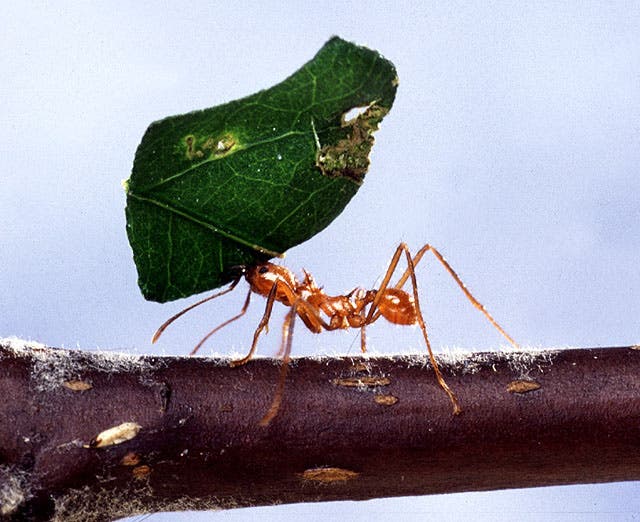There’s no work quite like teamwork — unless you’re a leaf-cutter ant.

Photo by Scott Bauer, public domain.
“Leaf-cutter ant” is a catch-many term referring to some 47 species of ants in 2 genera, Atta and Acromyrex, found in Central and South America. They all share the same way of life, feeding on fungi/mushrooms that they themselves grow in their mounds.
But agriculture is hard
Leaf-cutter ants form some of the largest and most complex communities on Earth, perhaps second only to our own. Factor in the scale of their infrastructure and how seamlessly it’s built, and we’ve just assumed that there must be some level of organization among the ants. New research shows, however, that this isn’t the case.
Public works
“Although many thousand individuals contribute to the construction of infrastructure, there is no communication or
organisation between them -— the massive foraging trails are a byproduct of the foragingbehaviour ,” said lead-author Thomas Bochynek from Northwestern University’s department of electrical engineering and computer science.
Leaf-cutter colonies can build nearly three kilometers of trails per year, and invest an average of 11,000 work-hours into constructing and maintaining them. Common wisdom held that such projects are handled through stigmergy — delegating tasks to specialists via direct or indirect communication among individuals. They were believed to leave behind pheromone trails to tell their fellow colony members where extra help is needed in removing a particularly heavy twig, for example.

Image credits Geoff Gallice / Wikimedia.
The team monitored colonies of leaf-cutter ants in the wild and in their lab to see how fast they could carve a path through debris and how many individuals would be assigned to the task. They also used computer models to establish the randomized rate of clearance based on each ant’s likelihood of encountering an obstruction by chance and then clearing it.
In essence, this last step gave the team a baseline value for how fast a colony could deal with new tasks. If the ants spent time communicating and organizing to clear a particular spot, the rate would temporarily go down. Once they were all set and got to work, this rate would go up.

Image credits Thomas Bochynek et al., (2019), PRSB.
What the team found, however, was an almost linear increase in the number of obstacles removed over time. This didn’t fit the hypothesis that the ants were coordinating. Instead, it suggested that ants went out and handled problems as they encountered them, taking no downtime to communicate and organize. The team believes ants evolved into this particular work ethic because it helps reduce overall energy expenditure for the colony (which means it can keep going on less food) and doesn’t require particular mental oomph from the ants.
“If you do not need to communicate, don’t!”, says Bochynek. “It saves the energetic expenditure of performing the
behaviour and reduces the required complexity in the individual animals.”
Needless to say, this is distinctively un-human behavior — but that’s what makes it interesting. Bochynek hopes his team’s results will help spur further research into how insects maximize energy efficiency and handle large-scale projects without oversight.
“Biologists and computer scientists are impressed by the fact that complexity in a group can come from simple individuals because it is so different from our own society,” he said.
“Showing that we can further reduce the minimum amount of complexity required in an individual to still see complex group
behaviour is henceexciting, and makes the trail clearing example more impressive in our opinion.”
One area where this research might be particularly interesting is robotics — particularly, robotic swarms and robot cooperation.
The paper “Infrastructure construction without information exchange: the trail clearing mechanism in Atta leafcutter ants” has been published in the journal Proceedings of the Royal Society B.









